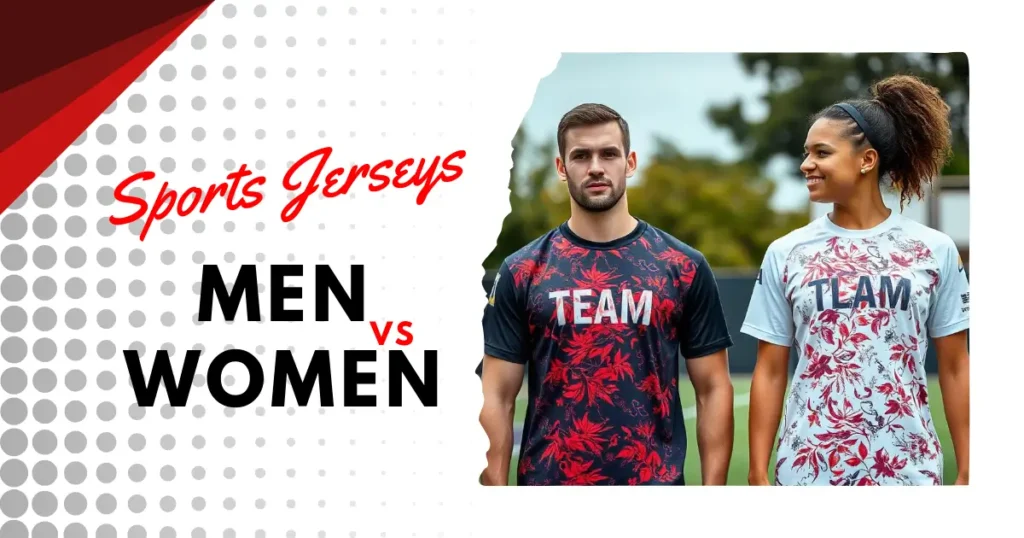
Differences Between Men’s and Women’s Sports Jerseys
Apart from the aesthetic differences that make them sporty, there are several differences highly kept between the sports jerseys worn by men and women. This will consider a variety of factors, including those touching on the different athletes, fans, and teams for comfortability and performance. This article is meant to depict major differences between sports jerseys for men and women based on design, fit, and material.
Why Understanding the Differences Matters
Whether you’re a clothing brand, a sports club, or a store owner, recognizing these distinctions can help you make better decisions for your teams, customers, and fans. For athletes, wearing the right jersey can enhance comfort and performance on the field. For brands, providing tailored options can set you apart in a competitive market. This understanding also allows for better marketing strategies, ensuring products meet the demands of diverse audiences.
Design and Fit
Some of the noticeable differences between the sports jerseys designed for men and women are related to design and fit.
- Cut for Comfort and Fit: Tailored fit allows for a slenderized waist, often with a slightly more fitted outline to the shape of the women’s body, while men’s jerseys are often cut boxy for a loose fit.
- Necklines and Sleeves: Often, women’s jerseys will be designed with things such as V-necks and cap sleeves; these add that touch of fashion without sacrificing the functionality of the jersey. Men’s jerseys are typically less dramatic and are often just crew necks with regular sleeves.
- Length and Hemline: Women’s jerseys are designed to be much more modest length-wise and they also have curved hemlines in order to ensure ease of movement and are considered more visually appealing.
Examples such as soccer jerseys designed for speediness or basketball shirts designed to allow ease of arm movement will explain these issues quite well.
Fabric and Comfort
The type of fabric used is very important in comfort during high-intensity activities. Here’s how men’s and women’s jerseys differ:
- Sweat Management: Women’s jerseys more often use lighter, wicking fabrics to account for different sweating patterns and temperature regulation needs. Men’s jerseys focus on durability and thicker fabrics to withstand rigorous use.
- Flexibility: Women’s jerseys can have more stretchable materials to allow for freedom of movement, especially in sports that demand agility and flexibility.
Highlight advancements in fabric technology, such as the use of recycled materials or nano-fiber moisture control, to make this section more forward-looking and appealing.
Functionality
Performance-driven design is key to any sports jersey. Here’s how functionality differs:
| Feature | Men’s Jerseys | Women’s Jerseys |
| Ventilation | Larger mesh panels for increased airflow | Strategically placed ventilation zones |
| Reinforcement | High-stress areas like shoulders and chest | Focus on ergonomic cuts to reduce chafing |
| Mobility | Looser fit for general movement | Created for flexibility/agility |
| Durability | Thicker fabrics for rugged use in contact sports | Stretchable materials for dynamic movements |
Style Preferences
While functionality is very important, aesthetics also play a huge role in designing sports jerseys.
- Color Choices: Women’s jerseys are often brighter-colored and with unique patterns, while men’s jerseys are more classic and bold.
- Customization: Teams and clubs consider gender when adding names, numbers, and logos to the jerseys. For women, print areas could be smaller or the typography could be refined to give a sleeker look.
Examples such as soccer jerseys designed for speediness or basketball shirts designed to allow ease of arm movement will explain these issues quite well.
Market Trends and Innovations
The sportswear industry is changing as brands focus more on inclusivity and performance-enhancing designs. Here are a few trends to watch:
- Unisex Jerseys: Many brands have now moved toward unisex options, incorporating the best of men’s and women’s jerseys to cater to all athletes.
- Sustainable Materials: A range of jerseys for men and women are made of eco-friendly fabrics and are produced using methods that are eco-friendly.
- Unisex Collections: These are collections that create a bridge between men’s and women’s design and allow people to be fluid.
Examples such as soccer jerseys designed for speediness or basketball shirts designed to allow ease of arm movement will explain these issues quite well.
Future of Gender-Specific Sportswear
As sportswear gets more advanced, the future of gender-specific jerseys looks promising and innovative:
- AI-Powered Customization: Brands are embracing AI technology to scan body shapes and movement patterns, thus offering super-personalized fits for both men and women.
- Sustainable Innovations: The focus on eco-friendly materials is likely to grow further, with jerseys made from bio-fabricated textiles and biodegradable fibers.
- Wearable Technology Embedded: Jerseys could integrate smart fabrics with embedded sensors that can trace vital signs or performance metrics related to things like heart rate, temperature, or movement.
More inclusivity and flexibility will have more examples of genderless design, bringing inclusivity while catering specifically to performance criteria.
Conclusion
Understanding the difference in men’s and women’s sports jerseys is key for clothing brands, sports clubs, and athletes alike. By paying attention to design, fit, material, and functionality, you will be in a position to make informed choices that can enhance both performance and satisfaction. Whether outfitting a team or stocking your store, offering tailored options can make all the difference.

